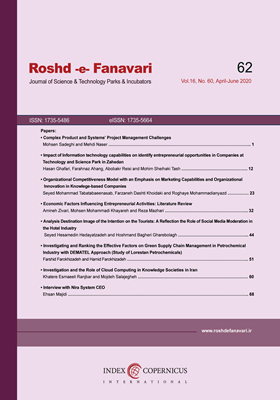Impact of Information Technology Capabilities on Identifying Entrepreneurial Opportunities in Companies at Zahedan Science Park and Technology
Subject Areas : Entrepreneurship and Mnagement of Knowledge-based FirmsHASSAN GHAFARI 1 , Farahnaz ahang 2 , ABOOBAKR REISSI 3 , MOHIM SHEYHAKI 4 *
1 -
2 - دانشگاه سیستان و بلوچستان
3 -
4 -
Keywords: Economics Technology Information Technology Identify Opportunities,
Abstract :
Organizations that have the technology and the ability to use it can recognize and exploit this opportunity. Technology is one of the most vital components of commercial and industrial organizations. The existence of efficient information technology system is the basis of IT capabilities. Active companies in science and technology parks, which have become an important element in today's knowledge economy, should be active in identifying entrepreneurial opportunities and taking advantage of the available opportunities in the most desirable way. Therefore, the present study attempts to investigate the effect of IT capabilities on the identification of entrepreneurship opportunities by survey method and based on interpretive structural modeling in the Smart-PLS software environment in growth companies in Zahedan science park and technology. The statistical population of this research is all employees of companies in Zahedan science park and technology. According to Morgan table, 130 people were selected randomly. The tool used in the research was a questionnaire. Reliability of the questionnaires was confirmed by Cronbach's alpha and combined reliability, and their validity was confirmed through convergent and divergent validity. The results of data analysis showed that IT capabilities have a positive and significant effect on the recognition of entrepreneurial opportunities by 0.472. Therefore, resident companies in Science and Technology Park should pay attention to the role of IT capabilities and its dimensions in identifying business opportunities.

